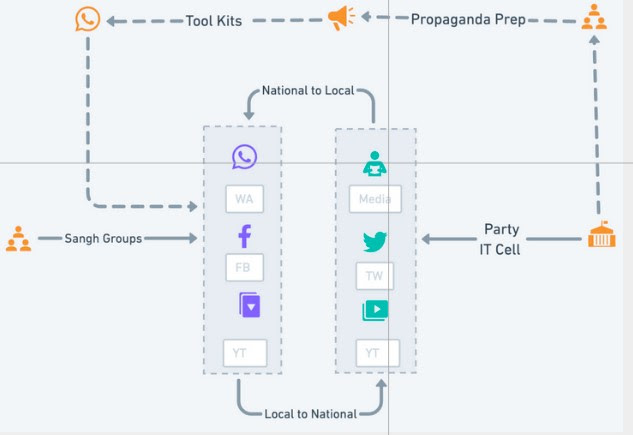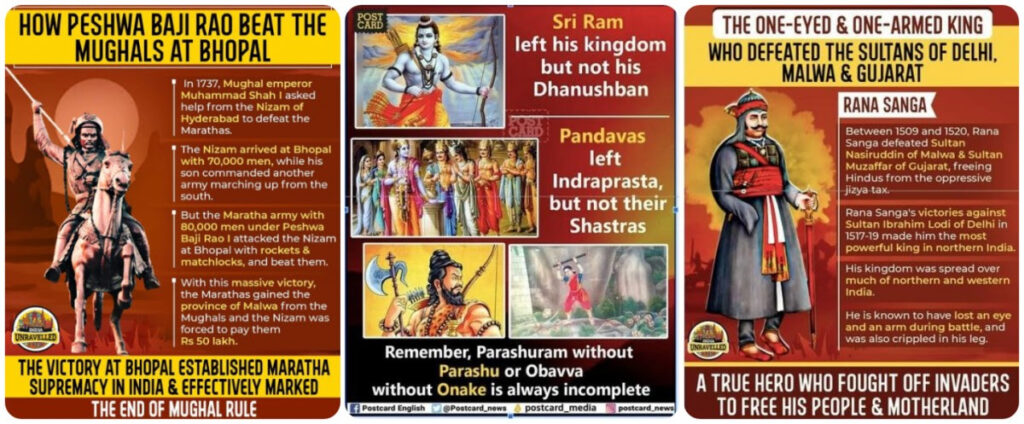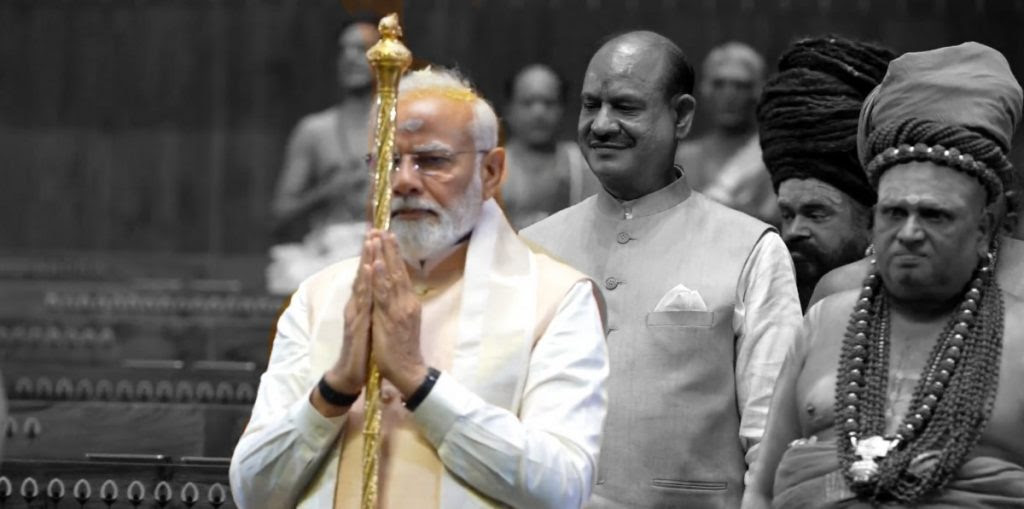My friend, a professor, moved to a new neighbourhood amidst the COVID-19 pandemic. Juggling a busy schedule at the university and taking care of her young daughter, she had yet to have the chance to meet many of her neighbours. She was conscious of this fact, but then something peculiar happened.
Last year, she received a call from a neighbour who, after a brief introduction, invited her to watch the film The Kashmir Files over the weekend. This invitation to watch a propaganda film rather than a simple coffee get-together struck my friend as odd and unexpected.
Upon further inquiry, she discovered a concerted effort within the neighbourhood through WhatsApp messages to encourage bonding over watching the film. It was presented as a civic responsibility to engage in community viewing.
This raises questions about the scale and reach of right-wing propaganda, as it has managed to infiltrate not only media houses and Twitter, but also local WhatsApp groups, shaping daily conversations and capturing local narratives. The incident prompts us to reflect on how a propaganda film with evident inaccuracies and biases could gain traction and be pushed through community platforms.
Social media platforms in India have become a breeding ground for manipulative practices to shape narratives and build public opinion.
This includes astroturfing, a technique used to create the illusion of grassroots support by orchestrating the narrative. It has been employed in various contexts, such as the targeted harassment of academics, campaigns against female activists, the politicisation of actor Sushant Singh Rajput’s death, the promotion of militarisation in Kashmir and even the online trolling of Chief Justice of India D.Y. Chandrachud.
This article will explore the methods used by right-wing propaganda machines to create a detailed framework. Through careful analysis of this design, we can gain valuable insights into how propaganda machinery operates and visualise its dynamics.

This propaganda design has distinct characteristics.
Propaganda narratives have deeply infiltrated various social media platforms and news channels, operating as a piece of well-orchestrated machinery at both local and national (even international) levels.
Numerous influencers and groups, both voluntary and ideologically driven, participate in amplifying these narratives, perpetuating a calculated narrative facilitated by IT cells, centralised machinery and think tanks. These propaganda narratives reach the mainstream through tweets, Facebook, WhatsApp, Instagram and YouTube to gain traction in the local community discussion.
Examples of such propaganda can be observed in films like The Kashmir Files and The Kerala Story, aiming to discredit Muslims while exploiting Hindu sentiments. Tragic incidents like the death of Sushant Singh Rajput were manipulated as distractions from pressing issues, concurrently targeting the Bollywood industry.
Notably, this machinery possesses the ability to transform national issues into local discussions, as seen with the transition of propaganda films evolving into ‘moral’ responsibilities, where communities are encouraged to engage in collective viewings. The exceptional nature of this propaganda machinery lies in its capacity to seamlessly shift the focus from local to national issues, such as when the Hijab debate was catapulted into a national discourse during the Uttar Pradesh election.
Right-wing propaganda machinery employs various methods to disseminate content, targeting local groups to shape narratives from the grassroots level. Issues like the sengol and Article 370 are skilfully framed through circulating materials in WhatsApp groups. Several materials are also circulating in such groups to emphasise the need for a uniform civil code. This strategic dissemination of narratives aims to influence public opinion.
Prime Minister Narendra Modi with the sengol in parliament on Sunday, 28 May, 2023. Photo: Screengrab from video
Obscure subjects like the sengol are promoted through local propaganda channels to amplify their significance. False information regarding historical figures like Nehru and Rajaji is intentionally spread, fostering discussions that favour Modi’s image.
Such manipulation of narratives sidesteps critical debates and deflects attention from crucial issues, exemplified by the overshadowing of Modi’s political motives behind inviting the Adheenam priests to inaugurate the new parliament.
Twitter serves as a national and international platform for such manipulation, with examples being the attack on the organisers of an international academic conference titled “Dismantling Global Hindutva” and the building of a narrative against the current chief justice. Twitter can shape narrative positions, with articles and TV shows following suit. Local issues gain momentum on Facebook and WhatsApp before being propelled to national media, sparking debates.
Influencers, as Cobrapost revealed, play a crucial role, being paid to promote specific messages through tweets. This ecosystem has expanded, with right-wing individuals benefiting financially and amplifying the intended message. YouTube is critical for driving local and national narratives through content creators.
The weaponisation of Hindu sentiment takes place through various methods, including the organisation of armed groups by entities such as the Bajrang Dal, Durga Vahini etc. Riots are often orchestrated to gain widespread support and foster a sense of inevitability in the midst of an enemy (read the outsider Muslim).
The orchestration of riots at local levels requires active participants and an audience who either feels threatened (in this case, minorities) or believes in justifying such acts (in this case, Hindus).
This is a challenging task, as the majority must feel that it was inevitable and that Muslims deserve the violence. This is done by highlighting recent incidents like stone-throwing on the Vande Bharat Express, “love jihad” or emphasising historical grievances.
However, this premise alone is not sufficient; the weaponisation of the Hindu mindset is equally crucial. Posters have been collected from Facebook sites and WhatsApp groups across a few states with straightforward messages that aim to revive the military achievements of Hindus. These messages are presented in a style that fits the format of WhatsApp, with large, easy-to-read fonts.

Narratives extolling the courage of local figures like Naiki Devi, Rana Sangha and Shivaji against the Mughals are disseminated through region-specific Facebook platforms and WhatsApp groups. These narratives aim to depict Muslims as aggressors and incite Hindus to adopt a militaristic stance.
Films like The Kashmir Files reinforce the notion that Hindu passivity will lead to the loss of their land, life and culture. Illustrations featuring Ram, the Pandavas and Parashurama carrying weapons during their exile are utilised to rationalise the necessity for arms and perpetuate a culture of war.
Saffron Swords, a book authored by Manoshi Sinha Rawal, chronicles 52 tales of resistance, often presenting Muslims as the antagonists. These stories, especially those involving battles with Muslim leaders, are transformed into posters that seek to incite the belief that Muslims were oppressors and Hindus fought against them. The book repeatedly characterises Muslim invasions as acts of genocide and involving the looting of temples and Indian wealth.
This narrative aligns with the agenda of the RSS, aiming to reshape the perception of Muslim arrival as an invasion, thereby casting Muslims as outsiders lacking legitimate claims to the subcontinent. The implementation of the national register of citizens can be interpreted as a legal manifestation of this narrative.

A case study conducted at the University of Michigan sheds light on the #HijabBan discourse on Twitter. Although the total number of tweets opposing the ban was higher, a smaller yet highly-engaged group of pro-ban accounts had a significant online reach.
This suggests that while the overall sentiment leaned against the ban, a vocal minority played a pivotal role in shaping the discourse. The use of astroturfing – the creation of artificial grassroots support – may have influenced the perception of a widespread backing for the ban.
It is crucial to comprehend the deeply entrenched nature of the right-wing design and its ability to disseminate narratives across local and national scales. Understanding this network can help in building countermeasures against fake news and hate propaganda, and establishing alternative, community-centric narratives to foster democratic discourse.
Collaboration between community media houses, influencers and activists on social media is crucial to promote constitutional and secular values for fostering harmony. By emphasising community-focused news reporting, we can document the aspirations of different communities and eventually build solidarity among them. Successful examples of this model are Khabar Lahariya and Eedina, which prioritise building media from the ground up.
Venkat Srinivasan is a financial professional with a master’s degree in economics. He is intensely interested in the media, arts, academia, and social issues related to development and human rights. The article also appeared in The Wire and is being republished with consent of the author
Related:
Film as Propaganda: the months between June 2023 & May 2024
Is GoI unwilling to investigate Facebook’s ecosystem of hate?
India’s Ecosystem of Hate: Is Facebook both, a Beneficiary and an Offender?
Facebook yet to take action against Bajrang Dal due to safety concerns: WSJ
Did Facebook just play a great Indian matchmaker and unite the Right, Left, and Centre?
After algorithm glitches Facebook CEO now talks of “operational mistake”
Delhi Govt’s Committee of Peace and Harmony to examine Facebook India’s role in Delhi riots
What is the BJP’s latest status update on Facebook?
Facebook protects hate speech by ‘regime favourites’ of ruling BJP?

